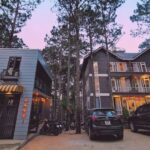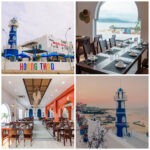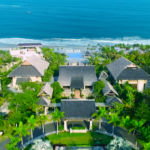Cocktails – Siêu Thị Điện Máy Chợ Lớn
Looking for a break from the glitz and glamour of Saigon’s central District 1, I decided to spend a day in Cholon, one of the city’s most unique neighborhoods. Cholon is Saigon’s Chinatown. In fact, it’s considered the largest Chinatown in the world by area. But its size isn’t the only thing that makes it special. Cholon isn’t merely just a fusion of Vietnam and China, but a mix of various Chinese diaspora communities as well. This results in some of the most fascinating and downright unusual pagodas I’ve ever come across.
Đang xem: Cocktails
Cholon was originally established by the Hoa, the name for the Chinese diaspora community in Vietnam. Many of them were merchants who came to Vietnam from the 17th century onward. And they continued to operate markets and trade centers in their new home down south. Cholon, in fact, even translates to “big market.” While once a separate and distinct city from Saigon, the two were eventually fused together by the French in the 1930’s. Now comprising most of Saigon’s District 5, Cholon still maintains a different feel from the rest of the metropolis.
Describing Cholon’s founders, the Hoa, as a single uniform culture can be misleading. Within the dim, smoky pagodas of Cholon, for example, you’ll find a mix of various cultures from within China, such as the Fujianese, Cantonese, Hainanese and Teochew. They would often bring their local folk deities with them to be enshrined in their new home abroad. Oftentimes, particular pagodas were established by a single ethnic group, with the structures doubling as both their places of worship and community centers.
It should be noted, by the way, that the term ‘pagoda’ takes on a slightly different term in Vietnam than it does elsewhere. In most Asian countries like China, Thailand or Indonesia, a pagoda refers to a tiered tower. These are usually religious in nature and often (but not always) part of a larger temple complex.
In Vietnam, on the other hand, a pagoda is most certainly a place of worship, but it doesn’t even necessarily need to feature the tiered tower (though it sometimes might). This is possibly due to an old custom of not wanting to upset feudal lords by building structures taller than their homes. Therefore, it’s best to think of a Vietnamese pagoda as more less what you’d call a basic temple complex in other countries. Though inside of the pagodas of Cholon, for instance, you’ll likely be a little surprised by what you find.


I hopped out of my Uber car and headed into my first stop for the day, Quan Am Pagoda, which was built by merchants in 1816. The place was fairly busy with local worshippers, heading to and fro with large bundles of incense and other offerings. The main deity enshrined here is Guan Yin, the Mahayana Buddhist goddess of compassion. But hers was far from the only shrine on display, immediately revealing the uniquely syncretic nature of Vietnamese pagodas.

The main Guan Yin shrine

Plumes of smoke in front of Taoist deities
In addition to the Buddhist Guan Yin, other deities here include the Amithaba (Pure Land) Buddha, various Buddhist Bodhisattvas and the Taoist Jade Emperor. At least of the ones I immediately recognized. While I’d visited plenty of Buddhist and Taoist temples before, I’d never come across a shrine dedicated to Mazu, a Chinese sea goddess worshipped by the Fujianese community. Immigrants probably felt the need to thank her after making it safely across the sea, and, as I would later learn, she’s among the most popular deities in Cholon.

Don”t miss the plaza across the street, which is technically a part of the main pagoda

Quan Am even has a shrine for the monkey from “Journey to The West,” a classical Chinese novel


A shrine to Mazu, one of Cholon”s most famous deities
I left Quan Am and headed to my next destination that was just across a busy road. Supposedly, it was right around here where the infamous Saigon Execution photograph was taken. The thought of that cold blooded killing happening right near where I walked was chilling. But the scene in that photograph and the Cholon of today, with its colorful shops and constant stream of motorbikes, might as well be different worlds.
Crossing the large road, I found the entrance to Phuoc An Hoi Quan Pagoda. This seems to be one of the smallest pagodas in Cholon, but it’s perhaps the district’s most intimate.
Aside from some lighting over the shrines, the interior of the pagoda was left almost completely dark. The openings in the roof, however, allowed for some of the most perfectly formed sunbeams to shine in from up above, illuminating the thick clouds of incense smoke. It almost looked as if you could reach up and grab them.
The pagoda was built back in 1902 and is dedicated to Quan Cong. The fact that Mr. Cong is not a religious deity, but a Chinese historical figure who never once stepped foot in Vietnam, further reveals the strength of the local traditions which the Chinese diaspora brought with them here.
Quan Cong was a military commander during the Three Kingdoms period. Born in Hangzhou during the tail end of the Han Dynasty, he rose to the rank of General for the Wu Kingdom. In battle, he was known for suppressing multiple rebellions in addition to winning skirmishes against the rival state of Wei. In his personal life, he was widely respected for his honesty and valor. Phuoc An Hoi Quan is far from the only pagoda to honor him, as I would soon find out.
Inside the pagoda, you can even find a statue of Quan Cong’s horse! Supposedly, locals bring offerings here before embarking on long or difficult journeys. Outside the shrine, don’t miss an additional shrine to Guan Yin, or the colorful, and rather unusual, guardian lion.
Xem thêm: Cho Thuê Xe Du Lịch Đi Cát Bà Du Lịch, Cho Thuê Xe Đi Đảo Cát Bà Du Lịch
Making a detour and a brief pause from pagoda-hopping, I journeyed West to the St. Francis Xavier Parish Church, also known locally at ‘Cha Tham.’ This 19th century structure is a fine example of French colonial architecture. And with its lack of tourists, it makes for a nice alternative to the Notre Dame Cathedral.
It turns out, though, that this relatively unassuming church is famous in Vietnamese history for another reason. This happens to be the place South Vietnamese president Ngo Dinh Diem took refuge after the bombing of the presidential palace (now known as Independence Palace). Hiding out with his brother, he was eventually discovered. He decided to surrender and cooperate with his captors, but he ended up being shot and killed anyway.
A visit to the peaceful church provided a nice change of scenery, but I felt it maybe could’ve used an incense cone or two.
I returned eastward and soon found myself walking down a cramped outdoor market street. Everything from fabrics to electronic parts were on sale here. Aside from pagodas, of course, Cholon is famous for its markets. It’s even home to Binh Tay Market, one of the largest in Saigon. But that was in the opposite direction, and if not looking for something specific, I’m not really a market person. As I dodged motorbikes and squeezed through whatever narrow space was left for pedestrians on the pavement, I was reminded of why.
Finally, I arrived at Chua Ong Bon Pagoda. Or at least where it was marked on my map. The side entrance I found appeared to be a family’s living room, with a few people lounging around and chatting inside. They didn’t pay me much attention as I cautiously stepped inside, still unsure if this was a residence! But fortunately, I was able to see the pagoda on the other end, and made my way through.
The main deity worshipped here is Ong Bon, the god of wealth and virtue. Placing his pagoda in the midst of the chaotic outdoor market was probably a good choice. Like many other pagodas in the neighborhood, this one was built by the Fujian Chinese, but it wasn’t constructed until after World War II.
In contrast to all the others I visited in Cholon, Chua Ong Bon was eerily deserted. It was a nice chance, at least, to freely explore a pagoda on my own before heading back out into the heat and traffic. Overall, though, there wasn’t a whole lot to see. I couldn’t tell if Chau Ong Bon is just very small, or if a good part of it was being blocked off for renovations. In any case, I moved on.
Thien Hau Pagoda is widely considered to be Cholon’s main attraction, and for the first time in the day, I had to share the space with tour groups in addition to the usual amount local worshippers. Nevertheless, there was still enough room to maneuver around and escape the crowds.
The first noticeable detail about Thien Hau Pagoda is the incense. All Cholon pagodas, of course, are filled with it. But Thien Hau Pagoda takes things to a whole new level, with multiple bowls of joss sticks all lined up in a row, forming a thick wall of smoke.
Built by the Cantonese community in the beginning of the 19th century, Thien Hau Pagoda is mainly dedicated to Mazu. “Thien Hau,” in fact, is Mazu’s name in Vietnamese. As mentioned above, Mazu is venerated as a sea goddess, though she was an actual historical figure in her lifetime. The living Mazu is said to have been a shamaness named Lin Moniang who lived in Fujian in the 900’s. According to some legends, she may have been an incarnation of Guan Yin, and developed multiple supernatural abilities which she used to save her family at sea from a typhoon.
In addition to the carvings, shrines and smoke, another notable feature of Thien Hau are the thousands of paper strips attached to the walls in the main hallways. The writing on each paper is a prayer, and as they get rustled in the wind, locals believe that the intentions of those prayers get sent to Mazu herself. Taking that into consideration, it made sense why Thien Hau Pagoda has a large open courtyard, and is overall much brighter than its neighbors.
Just a little further east down the street was my last stop of the day: Nghia An Hoi Quan Pagoda. This wouldn’t be my first encounter of the day with Quan Cong and his legendary horse, some of the main “deities” enshrined here. But this pagoda also pays special tribute to Nghia An, none other than the horse’s groom! Before setting off for Vietnam, I never would’ve guessed that I’d get the chance to pray at a shrine dedicated to an ancient Chinese horse groomer.
Some other deities worshipped here include familiar faces from other nearby pagodas, such as Ong Bon, the god of wealth. And there also appear to be a number of Taoist deities, like the Jade Emperor, enshrined here as well. With the constant mix of historical and mythological figures from different regions and religions, though, it’s not always easy to figure out who is who. But that’s part of what makes these Cholon pagodas so alluring.
Xem thêm: Top 10 Quán Bún Đậu Mắm Tôm Ngon Ở Đà Nẵng, Bỏ Túi 20 Quán Bún Đậu Mắm Tôm Ngon Ở Đà Nẵng
Compared to Thien Hau Pagoda, things were much more peaceful in Nghia An Hoi Quan Pagoda. It was just me and three of four other locals. But I had a strong feeling that the tour group from down the street would soon be on its way, perhaps a sixth sense granted to me by Mazu. I decided to call it a day, walking away from the smoke and the shadows, and back out into the scorching sun of a bustling Saigon.






Bình luận